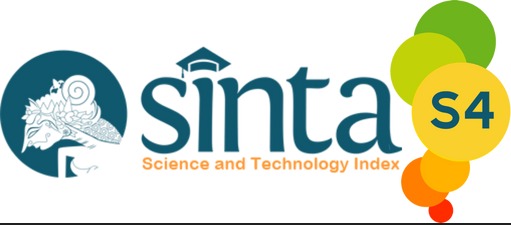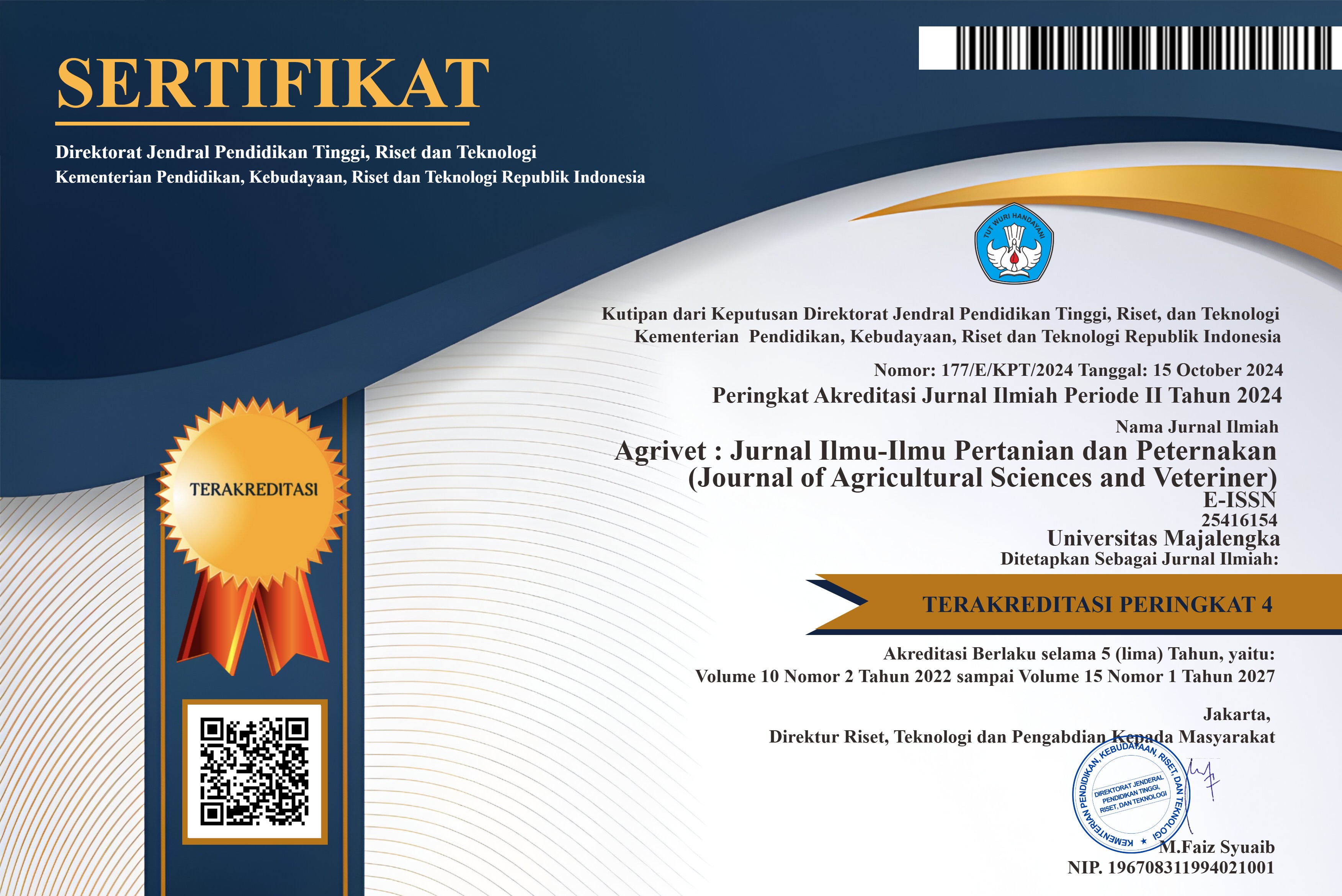Peningkatan performan entog dengan pemberian ransum komplit berbasis batang pisang
DOI:
https://doi.org/10.31949/agrivet.v11i1.5738Abstract
Muscovy duck was in demand by breeders because of easy maintenance, fast growth, and quick yielding. But muscovy ducks have a high level of ration consumption, resulting in high production costs. An alternative solution used cheap, abundant, and good feed nutrient ingredients, including banana stems. The objective of the research was to obtain the best performance of muscovy duck served a complete ration based on banana stems. The method used was an experimental method with a completely randomized design to 100 ducks with 5 treatments and 4 replication P0 (ration without (0%) banana stems), P1 (ration containing 25% banana stems), P2 (ration containing 50% banana stems), P3 (ration containing banana stems 75%), and P4 (85% banana stems). Maintenance of muscovy duck started from 4 to 12 weeks of age. The variables observed were ration consumption, body weight, and ration conversion. The results showed that the muscovy duck which was served a complete ration containing 50% stems showed the best musk performance, including ration consumption of 31,42+0,00 kg, daily ration consumption 52,37+0,00 gram/day, bodyweight of 24,27+0,00 kg, body weight gain 40,46+0,01 gram/day and ration conversion of 1.29+0,00. In conclusion, the best complete muscovy duck ration contains 50% banana stems.
Keywords:
complete ration, banana stem, muscovy duckDownloads
References
Abdel-Hamid, S. E. S., Shahin, S. E., & Rehan, I. F. (2020). Organic selenium supplementation: A convenient approach to improve behaviour, performance, and economics and to suppress stress in home-cage reared ducks. Journal of Animal Health and Production. https://doi.org/10.17582/journal.jahp/2020/9.s1.9.16
Anggraeni, A. S., Istiqomah, L., Damayanti, E., Anwar, M., Sakti, A. A., & Karimy, M. F. (2018). Cellulolytic yeast from gastrointestinal tract of muscovy duck (Anas moscata) as probiotic candidate. Journal of the Indonesian Tropical Animal Agriculture. https://doi.org/10.14710/jitaa.43.4.361-372
Arroyo, J., Lavigne, F., & Fortun-Lamothe, L. (2017). The influence of whole-corn feeding method during the finishing stage on the performance of overfed mule ducks. Poultry Science. https://doi.org/10.3382/ps/pex112
Ayuningtyas, G, Jakaria, Rukmiasih, dan c, B. (2016). Produktivitas Entok Betina dengan Pemberian Pakan Terbatas Selama Periode Pertumbuhan Productivity of Muscovy Duck with Restricted Feeding in Rearing Period. Jurnal Ilmu Produksi Dan Teknologi Hasil Peternakan.
Baéza, E., Chartrin, P., Bordeau, T., Lessire, M., Thoby, J. M., Gigaud, V., Blanchet, M., Alinier, A., & Leterrier, C. (2017). Omega-3 polyunsaturated fatty acids provided during embryonic development improve the growth performance and welfare of Muscovy ducks (Cairina moschata). Poultry Science. https://doi.org/10.3382/ps/pex147
Castillo, A., Schiavone, A., Cappai, M. G., Nery, J., Gariglio, M., Sartore, S., Franzoni, A., & Marzoni, M. (2020). Performance of slow-growing male muscovy ducks exposed to different dietary levels of quebracho tannin. Animals. https://doi.org/10.3390/ani10060979
Damaziak, K., Michalczuk, M., Adamek, D., Czapliński, M., Niemiec, J., Goryl, A., & Pietrzak, D. (2014). Influence of housing system on the growth and histological structure of duck muscles. South African Journal of Animal Sciences. https://doi.org/10.4314/sajas.v44i2.1
El. Abdel-Hamid, S., & Abdelfattah, E. M. (2020). Effect of different dietary protein levels on some behavioral patterns and productive performance of muscovy duck. Advances in Animal and Veterinary Sciences. https://doi.org/10.17582/JOURNAL.AAVS/2020/8.6.661.667
Etuk, I. F., Abasiekong, S. F., Ojewola, G. S., & Akomas, S. C. (2006). Carcass and organ characteristics of muscovy ducks reared under three management systems in South Eastern Nigeria. International Journal of Poultry Science. https://doi.org/10.3923/ijps.2006.534.537
Etuk, I. F., Ojewola, G. S., & Abasiekong, S. F. (2006). Performance of muscovy ducks under three management systems in South Eastern Nigeria. International Journal of Poultry Science. https://doi.org/10.3923/ijps.2006.474.476
Ewuola, M. K., Akinyemi, M. O., Hassan, W. A., & Folaniyi, B. S. (2020). Morphological Diversity of Muscovy Duck in Humid Zone of Nigeria. Journal of Agriculture and Ecology Research International. https://doi.org/10.9734/jaeri/2020/v21i230131
Farghly, M. F. A., El-Hack, M. E. A., Alagawany, M., Saadeldin, I. M., & Swelum, A. A. (2018). Wet feed and cold water as heat stress modulators in growing Muscovy ducklings. Poultry Science. https://doi.org/10.3382/ps/pey006
Hadi, R. A. (2019). PEMANFAATAN MOL (MIKROORGANISME LOKAL) DARI MATERI YANG TERSEDIA DI SEKITAR LINGKUNGAN. AGROSCIENCE (AGSCI). https://doi.org/10.35194/agsci.v9i1.637
Kurniawan, A. (2018). Mol Production (Local Microorganisms) With Organic Ingredients Utilization Around. Jurnal Hexagro.
Manullang, R. R., Rusmini, R., & Daryono, D. (2018). KOMBINASI MIKROORGANISME LOKAL SEBAGAI BIOAKTIVATOR KOMPOS Combination of Local Microorganism as Compose Bioactivators. Jurnal Hutan Tropis. https://doi.org/10.20527/jht.v5i3.4793
Mohammed, A. A. A., Abdel-rahman, M. A. M., & Darwish, M. H. A. (2015). Influence of Swimming Deprivation on Behavior , Performance and some Blood Parameters of Muscovy Ducks. Journal of Advanced Veterinary Research.
Ramadhan, F. K., Rukmiasih, & Afnan, R. (2019). Penggunaan Ekstrak Pelepah Pisang Ambon sebagai Sanitizer Kerabang terhadap Daya Tetas Telur Itik Lokal. Jurnal Ilmu Produksi Dan Teknologi Hasil Peternakan. https://doi.org/10.29244/jipthp.7.3.88-95
Rochlitz, I., & Broom, D. M. (2017). The welfare of ducks during foie gras production. Animal Welfare. https://doi.org/10.7120/09627286.26.2.135
Santos, A. N. A., Cruz, F. G. G., Oliveira Filho, P. A., Farias, T. M., Rufino, J. P. F., & Viana Filho, G. B. (2020). Sodium requirement for Muscovy ducks in housing. Revista Brasileira de Ciencia Avicola. https://doi.org/10.1590/1806-9061-2018-0936
Soipeth, U., Tongpim, S., Leelavatcharamas, V., & Khammeng, T. (2016). Fungal Fermented Protein (FFP) : Alternative Ingredient to be Used in Muscovy Duck Diets. Turkish Journal of Agriculture - Food Science and Technology. https://doi.org/10.24925/turjaf.v4i2.92-96.553
Suci, D. margi, Zahera, R., Sari, M., & Hermana, W. (2020). PenggunaanTepung Kulit Pisang dalam Ransum terhadap Kadar Kolesterol, Vitamin A, Profil Asam Lemak Kuning Telur Ayam Arab. Jurnal Ilmu Nutrisi Dan Teknologi Pakan. https://doi.org/10.29244/jintp.v18i1.30846
Tugiyanti, E., Yuwanta, T., Zuprizal, Rusman, & Ismoyowati. (2016). Effect of α-tocopherol and ascorbic acids on performance and blood immunity profile of male native muscovy duck. Journal of the Indonesian Tropical Animal Agriculture. https://doi.org/10.14710/jitaa.41.3.145-152
Wawro, K., Wilkiewicz-Wawro, E., Kleczek, K., & Brzozowski, W. (2004). Slaughter value and meat quality of Muscovy ducks, Pekin ducks and their crossbreeds, and evaluation of the heterosis effect. Archives Animal Breeding. https://doi.org/10.5194/aab-47-287-2004
Published
How to Cite
Issue
Section
License
Copyright (c) 2023 Dini Widianingrum, Iwan Setiawan, Oki Imanudin, Rachmat Somanjaya

This work is licensed under a Creative Commons Attribution-ShareAlike 4.0 International License.
An author who publishes in the Jurnal Agrivet agrees to the following terms:
- Author retains the copyright and grants the journal the right of first publication of the work simultaneously licensed under the Creative Commons Attribution-ShareAlike 4.0 License that allows others to share the work with an acknowledgment of the work's authorship and initial publication in this journal
- The author is able to enter into separate, additional contractual arrangements for the non-exclusive distribution of the journal's published version of the work (e.g., post it to an institutional repository or publish it in a book) with the acknowledgment of its initial publication in this journal.
- The author is permitted and encouraged to post his/her work online (e.g., in institutional repositories or on their website) prior to and during the submission process, as it can lead to productive exchanges, as well as earlier and greater citation of the published work












